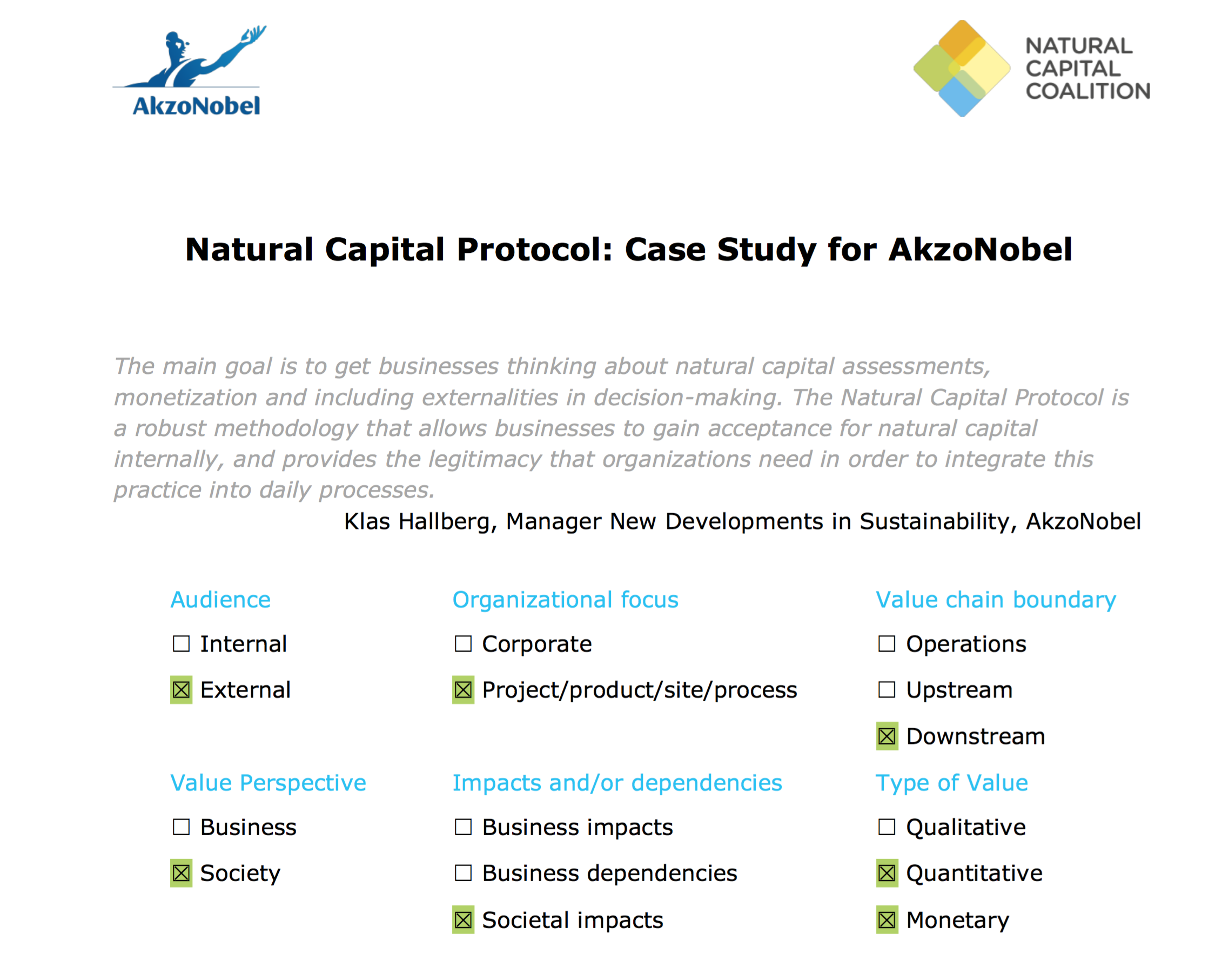The company in brief:
AkzoNobel is a Dutch multinational chemical company, producing paints, performance coatings and speciality chemicals, and supplying paint ingredients, protection and colours to a worldwide industry and consumer base. The company’s products are also inputs to a variety of industrial manufacturing streams for pharmaceuticals, pulp and paper, and in the production of consumer items including ice cream, bakery goods, cosmetics, plastics and glass.
AkzoNobel had previous knowledge of natural capital assessment, so were readily able to apply and interpret the Natural Capital Protocol and its outputs. Their experience included having previously implemented standards such as ISO 14040/14044 Life Cycle Assessment and a number of other methodologies, frameworks and guidelines for natural capital, as well as several tools that were developed in-house.
Why a natural capital assessment?
AkzoNobel applied the Natural Capital Protocol to a product in their downstream value chain – a book. AkzoNobel does not produce books, but its end customers do. AkzoNobel were interested to know the extent to which its chemicals, when applied to book production, resulted in appreciable natural capital impacts, and how these compared with other inputs to the production process.
Why did AkzoNobel select this particular end product? This was principally because they were looking for a tangible output from their value chain that people in society could relate to. Their contribution to the book value chain is in chlorate production, used to produce the beaching agent used to whiten paper. As well as societal impacts, AkzoNobel were interested in using the outcomes of the natural capital assessment to identify and implement initiatives for continual business improvement.
How was the Natural Capital Protocol used?
The assessment had both a business and societal focus. AkzoNobel applied the Scoping, and Measure and Value stages of the Protocol, with output intended for internal and external stakeholder audiences.
The natural capital assessment was supported at AkzoNobel up to senior executive level. The company’s management team was in favour of the assessment as a means of guiding future investments and becoming more transparent as a company. The part of the business under review represented around 10% of turnover, or 1.5bn euros per annum. By focussing on their downstream value chain, AkzoNobel considered the impacts of their customers in paper production (e.g. forestry, land use) and bleaching (e.g. chemical manufacturing), with the aim of identifying risk and opportunity hotspots.
What were the outcomes of the assessment?
Existing know-how within AkzoNobel represented a significant time saving for Protocol implementation, and reduced the need to seek external assistance to the process. An important learning was that the assessment was data intensive, particularly in the Measure and Value stage.
AkzoNobel’s assessment evidenced that the chemicals used in bleaching were found to have only a small contribution to the total natural capital impact of the production of a book. The assessment offered new insights into the book value chain more generally, identifying areas for future improvement. The assessment facilitated interactions with customers (pulp manufacturers) to explore ways to reduce impacts.
AkzoNobel subsequently applied the same methodology to their bleaching chemicals production process as a whole, and through this additional impact assessment, were able to define specific actions to improve the performance of production sites. These include reducing energy use and footprint by a move to more renewable electricity.
AkzoNobel found the Protocol to be a comprehensive framework that can be labour intensive to apply fully. Their advice to other businesses is to consider early on how existing measurement approaches can be leveraged into the Protocol framework, or whether it is necessary to customize approaches to specific studies. Leveraging existing approaches can save a lot of resources and even potentially offer consistency across many types of natural capital assessment.
Next steps:
AkzoNobel were successfully able make use of the Scoping, and Measure and Value stages of the Protocol as part of their assessment. They now wish to use the Apply stage of the Protocol to help with implementing the outcomes. In addition, the company sees value in broadening the assessment out to a corporate focus, to take in more aspects than they were able to assess with focus on a single downstream product only.
AkzoNobel sees the Protocol as the next stage in an ongoing sustainability journey within the company, one that historically looked only at carbon in direct operations but has evolved over a number of years and now includes hundreds of other impacts and dependencies, and more parts of the value chain. In addition, more high level interest in the Protocol has started to emerge within the business, taking its influence beyond a single business unit.
AkzoNobel will continue to use the Protocol to inform their thinking around business decisions. They intend to use conservative, publicly available methodologies and would like to see more consistency introduced into natural capital valuation, as use of the Protocol increases among businesses. They are continuing to seek simple, specific and streamlined tools and calculation methods and believe that these will be critical to ensuring uptake of natural capital assessments, and making them manageable for companies.












